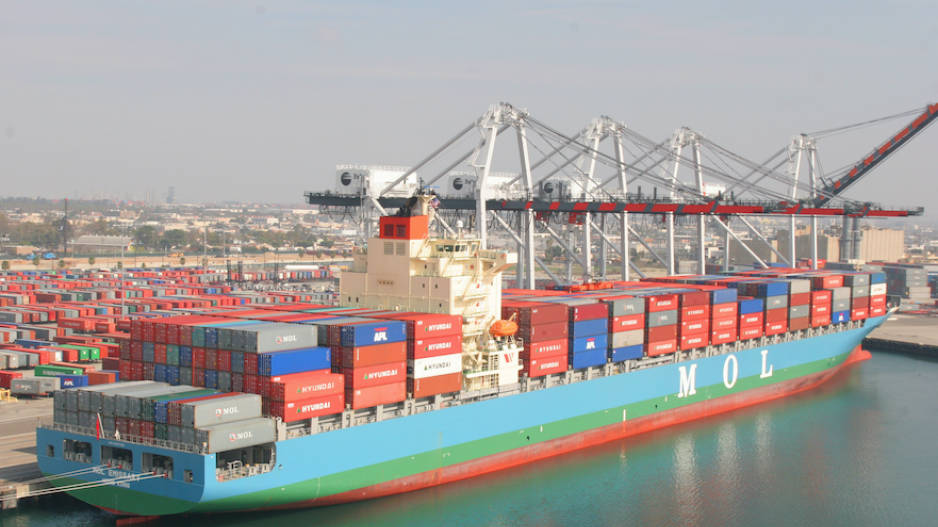Contracted cash flow up 251%, profit up 450%; cargo capacity up 83%.
The third-quarter financials tell the tale for global container cargo shipping companies based in Vancouver and elsewhere around the world: the ocean freight market is sizzling.
The president and CEO of Atlas Corp. (NYSE:ATCO) put it mildly during the third-quarter earnings call for the parent company of Vancouver-based Seaspan Corp. when he said that “the container shipping market continues to experience favourable conditions thanks to a strong recovery in trade volumes combined with ongoing supply chain disruption.”
Favourable is a major understatement.
Bing Chen added that the disruption, which has reached historic proportions at California’s main Los Angeles-Long Beach container cargo hub, “has absolutely no impact on our business.”
Again, the numbers tell the tale for Seaspan, which is celebrating its 20th anniversary this year and is now the world’s largest lessor of container ships.
Its fleet has grown to 201 from zero since 2001. The total includes the 70 new vessels contracted in the past year. That raises Seaspan’s fleet capacity to 1.9 million 20-foot-equivalent units (TEUs), which is up 83% in 2021 compared with 2020. Gross contracted cash flow for Atlas hit US$17.9 billion as of September 30, up 251% from December 31, 2020, while Seaspan’s Q3 profit increased 31% to US$256 million from US$196 million in 2020’s third quarter.
Bigger fish in the container shipping pool also posted robust third-quarter financial results.
Third-quarter 2021 profit from the ocean operations of A.P. Moller-Maersk (CPH:-MAERSK-B), the world’s largest container shipping company, jumped to US$5.3 billion from US$968 million in 2020’s third quarter. The 447% increase is part of the boom in maritime cargo and trade that started unexpectedly in 2020’s second half and has continued well into 2021.
Collectively, the global container-shipping sector posted profit of around US$39 billion in 2021’s second quarter and is projected to reap US$150 billion in 2021.
The outlook beyond this year for containerized cargo remains bright.
Drewry estimates global port handling of containers to increase 8.2% this year compared with 2020.
That is down from the U.K.-based shipping consultancy’s 10.1% estimate given three months ago, but it remains a 7.2% increase over pre-pandemic 2019.
The most recent shipping market review from Danish Ship Finance (DSF) estimates the average increase in global container throughput in 2021’s second and third quarters was 25%, driven in large part by a 21% increase in U.S. goods spending.
But it sees a shift in the tide on the horizon for container shipping.
The Denmark-based ship financing company projects overall growth in the world’s seaborne trade to slow to 3% in 2022 and points out that the global container fleet will expand significantly in 2023 and 2024, driven by an influx of larger 15,000 TEU ships.
That capacity increase, the highest since the financial crisis, coupled with softening demand could set the stage for what DSF sees as a potentially “severe downturn in 2023 … [that] could create market challenges not seen for many years.”
Drewry has also noted that an anticipated mismatch between supply and demand in 2023 presents a risk of overcapacity for ocean carriers.
That tidal shift in the market for ocean carriers and companies that service the sector raises concerns over Seaspan’s recent rapid expansion.
Responding to analysts’ questions during the Atlas-Seaspan Q3 earnings call about the prudence of that expansion, Chen pointed out that all Seaspan’s newbuilds are backed by long-term charter agreements.
He emphasized that the company focuses on long-term cash flow certainty and “predictability over short-term gains through long-term charters with quality counterparts. Which is why our business model is resilient in all market conditions such as the trade war and current pandemic.”
Chen has said in previous earnings calls that supply and demand in the container-shipping arena remains fundamentally balanced and that he is confident in forecasts of solid demand growth in the sector over the next few years.
Atlas chairman of the board David Sokol added that the focus of the company’s board and management team is to build an organization that lasts.
He said the shipping sector’s small owner-operator support mechanisms, “if you look back, five and 10 years, [were] very short-term oriented – trying to take advantage of price spikes, and trying to avoid, when possible, the trough that occurs. That’s not a game that we want to play.”
He pointed out that Seaspan has nearly US$18 billion in long-term contracts.
“No one in this industry’s ever even approached numbers like that.”
That, he said, has in large part inoculated Seaspan’s business against such major market dysfunction as the current port congestion plaguing North America’s West Coast.
“The fact that there is a lot of congestion affecting a lot of shippers … is unfortunate. But our economics don’t change because we get paid whether the ships are waiting in line to get to port or whether they are being unloaded and reloaded in port.” •
@timothyrenshaw




